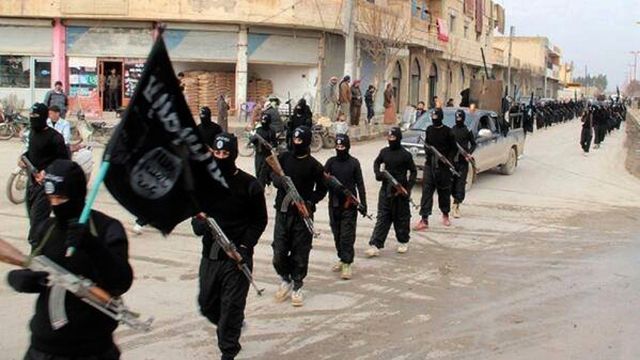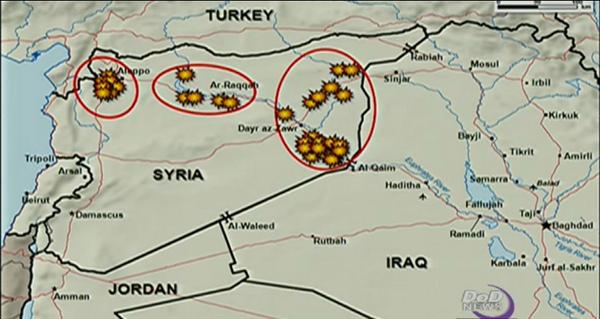
Editor’s note: For more background, see: “A Primer: What is the Islamic State, and Why Are We Fighting Them?”
On Tuesday, the Pentagon announced that US forces had struck multiple targets in Syria in a dramatic expansion of the air campaign against the Islamic State already underway in Iraq. The airstrikes, undertaken with the assistance of several Arabic states, were seen by many observers as being more expansive than Obama had suggested in his Sept. 10 speech announcing his strategy to combat the Islamic State.
Wondering how we got here? Want to know more about precisely whom we’re attacking — and who’s supporting us in the effort? Below, we’ve rounded up some key news and analysis to help you make sense of the latest chapter in America’s 13-year-long “War on Terror.”
What’s happening now?
Hannah Allam reports for McClatchy that the first wave of US-led airstrikes “used a mix of fighters, bombers and Tomahawk missiles.” According to The Washington Post, the White House gathered a coalition of partners for the attacks that included Bahrain, Saudi Arabia, Jordan and the United Arab Emirates. Qatar was also named as a member of the coalition, but it’s not clear whether it participated directly in the military action or merely lent its support. The administration took pains to make this intervention a multilateral action, with support from Muslim-majority countries, but as The Post notes, Turkey — a close ally of Washington that shares a long border with Syria, was noticeably absent.
Washington Post national security reporter Dan Lamothe tweeted this map, provided by the Pentagon, showing the locations of the initial round of strikes:

(Vox offers “27 maps that explain the crisis in Iraq.”)
Another wave of strikes on Wednesday targeted modular refineries in Eastern Syria, in an attempt to disrupt the Islamic State’s cash flow — the militant group is believed to be getting around $2 million per day in illicit oil revenues, according to Ha’aretz. Aircraft from Saudi Arabia and the UAE took part in the offensive.
While Obama repeatedly referred to the need to “degrade and ultimately destroy” the Islamic State in his Sept. 10 address to the nation, targets have “included not only positions belonging to the Islamic State, but also bases in three provinces of its chief jihadi rival, the al Qaida-affiliated Nusra Front,” according to McClatchy. Hannah Allam writes:
US officials have long worried that hitting just the Islamic State would end up empowering other entities the US did not want to strengthen, including Nusra and the government of President Bashar Assad.
Another force targeted in the strikes is Khorasan, a previously little-known group that administration officials say may pose a more direct threat to the US and other Western nations than the Islamic State. While most analysts agree that the latter is focused primarily on battling for territory within the Middle East, Jenna McLaughlin and Dana Liebelson report for Mother Jones that Khorasan aspires to launch 9/11-style attacks on the West:
Senior administration officials, speaking on background, said that Khorasan had established a safe haven within the chaos of Syria to plot attacks against the United States and other Western nations. One official reported that this planning was “nearing the execution phase.” A senior administration official also said that Khorasan — described as a band of experienced al-Qaida veterans — was recruiting Westerners fighting in Syria for “external operations,” and that Khorasan plotting had prompted the United States to beef up aviation security measures a few months ago. One administration official noted that President Obama had been contemplating strikes against Khorasan for months “separate and apart from the growing threat from ISIL.”
Craig Whitlock reports for The Washington Post that defense officials say this is merely the beginning of “a prolonged campaign that will continue intermittently for months and will become more difficult as targeted militants seek refuge in populated areas.”
Yesterday in New York City, Obama “presided over a rare and significant session” of the UN Security Council in which, ABC News reports, “leaders of 15 nations voted to unanimously adopt a resolution aimed at stopping the flow of foreign terrorist fighters across the globe.”
The National Counterterrorism Center says there are about 15,000 individuals from 80 countries fighting or training with Islamic extremists inside Syria and Iraq. The total includes an estimated 2,000 Europeans and over 100 Americans who “have attempted to go or have gone.” The FBI says some US fighters, who received training abroad and/or fought alongside rebel groups in Iraq or Syria, have returned to the United States and are under active monitoring.
Will this work?
Across the world and the US political spectrum, there’s quite a bit of skepticism that an air campaign can accomplish the goal of degrading and ultimately destroying the Islamic State.
On Sept. 16, Gen. Martin Dempsey, the chairman of the Joint Chiefs of Staff, told Congress that Obama’s pledge of “no boots on the ground” may not be set in stone. And Craig Whitlock reports for The Washington Post that “a series of military leaders have criticized the president’s approach against the Islamic State militant group.”
Juan Cole, a professor of Middle East studies at the University of Michigan, writes that “Shock and Awe… never works.”
[The] sorties flown on Monday will have killed some ISIL terrorists, blown up some weapons warehouses, and destroyed some checkpoints. But ISIL are guerrillas, and they will just fade away into Raqqah’s back alleys. The US belief in air power is touching, but in fact no conflict has ever been quickly brought to an end where US planes have been involved. The ISIL guerrillas will fade away, perhaps inside the city, where you can’t bomb them without killing a lot of civilians (and they will video the victims for you). Then there will just be occasional drone strikes of the sort that were relatively ineffectual in Afghanistan and FATA in Pakistan.
The US dropped enormous numbers of bombs on Iraq since 2003, and in the end its sponsored government lost 40% of the country to ISIL. Bombing positions in Syria in the absence of an allied ground force is highly unlikely to be decisive in and of itself.
Zuri Linetsky writes at The American Prospect that US military action is doomed to failure absent a more holistic approach to strengthening the governance in Iraq and other failed states so that people don’t feel the need to turn to “quasi-state entities” like the Islamic State for protection or for the provision of basic services.
The ground forces on which Obama’s plan rests — the Iraqi military and “moderate” Syrian rebels — are problematic. As the Islamic State surged through Northern Iraq, there were multiple reports of Iraqi soldiers dropping their weapons and fleeing. On Sunday, Islamic State militants dealt the Iraqi Army its biggest blow since demolishing several divisions of troops in June when suicide bombers attacked a base in Anbar Province, leaving between 300 and 500 soldiers either dead or missing. Loveday Morris reports for The Washington Post that “the chaotic incident has highlighted shortcomings in an army that the United States has spent billions of dollars training and equipping, and it has further undermined the force’s reliability as a partner as President Obama expands airstrikes into provinces including Anbar.”
While the Saudis have agreed to allow US forces to use their territory to train “moderate” Syrian rebels, there are a number of reasons to question the potential effectiveness of these forces. Not only have past efforts to arm these groups resulted in American weapons falling into the hands of the Islamic State, but there have been conflicting reports about whether these very rebel groups struck a non-aggression pact with the militant group; their first priority remains toppling the regime of Bashar al-Assad.
They’re not pleased with the fact that Assad’s forces aren’t being targeted. McClatchy’s Jonathan Landay reports that “rebel commanders gave a mixed assessment of US-led airstrikes in northern Syria on Tuesday, saying that some of the Islamic State encampments hit had been evacuated and one building that was struck had been filled with displaced civilians.”
The greatest damage, they said, may be to the Free Syrian Army, the moderate rebel faction that enjoyed U.S. support for years. By focusing exclusively on Islamic State insurgents and al Qaida figures associated with the Khorasan unit of the Nusra Front, and bypassing installations associated with the government of President Bashar Assad, the airstrikes infuriated anti-regime Syrians and hurt the standing of moderate rebel groups that are receiving arms and cash as part of a covert CIA operation…
US officials assured Iran that Assad’s troops would not be hit, according to Reuters. The Associated Press reports that the US, through intermediaries, also informed Assad in advance of the strikes.
This puts the Obama administration in a difficult position. Having condemned the Assad regime calling for him to step down last year, they are now in a position of indirectly helping the dictator remain in power. The AP reports that “President Bashar Assad said Tuesday he supports any international effort against terrorism, apparently trying to position his government on the side of the US-led coalition conducting airstrikes against the Islamic State group in Syria.”
More generally, the US has a notably poor track record arming rebel groups and using them as proxies to pursue its interests, as Greg Myre detailed this week for NPR.
The big concern(s)
Many progressive analysts worry that while it appears that Obama’s desire to not get drawn into another ground war in the Middle East is sincere, he overpromised when he established the expectation that US forces would stamp out the Islamic State (see, for example, David Corn writing for Mother Jones). With a majority of the American public in favor of military action against the militant group, and hawkish pundits calling the air campaign a half-hearted measure, the question is what might happen if the air campaign fails to achieve the president’s stated goals.
More broadly, an expanded air campaign will result in civilian casualties — eight civilians were reportedly killed in Tuesday’s strikes — which threatens to result in “blowback” against the US-led coalition.
Are these attacks legal?
It depends on whom you ask, and whether we’re talking about domestic law or the patchwork of treaties and norms known as international law.
The administration argues that it may undertake these attacks without further approval from Congress under the 2001 Authorization for the Use of Military Force (AUMF) against Al Qaeda. One of the problems with that argument is that al-Qaida has officially disassociated itself from the Islamic State.
As far as international law, Dan Roberts reports for The Guardian that “US government lawyers have invoked Iraq’s right to self-defense and the weakness of the Assad regime as twin justifications for US bombing in Syria, in a feat of legal acrobatics that may reopen questions over its right to intervene in the bitter civil war.”
The US also argued that there was legal right to pursue Isis inside Syria due to the weakness of that country’s government – a regime the US has been actively urging be undermined by rebel groups for much of the past two years…
[T]his means arguing that Isis is equivalent to al-Qaida, even though the groups are split – logic that several critics in Congress, such as Virginia Sen. Tim Kaine, have argued is flawed and requires a fresh authorization to fix…
[US Ambassador to the UN Samantha] Power… argu[ed] that Tuesday’s separate attack on Khorasan rebels in Syria was also an act of self defense by the US due to the group’s closeness to al-Qaida.
As Mark Goldberg explains, the UN Charter not only empowers states to defend themselves, but also enshrines the principle of “collective self-defense.”
But there are three problems with the administration’s argument; one a matter of process and the other two issues of substance.
As for the process, while the US cited Iraq’s right to collective self-defense in its letter to the Security Council, as of this writing, the Iraqi government has not done so itself. Similarly, US officials probably notified the Assad regime of the attacks to make the case that the Syrian government offered implied consent to the air campaign.
UN General Secretary Ban Ki-Moon appears to have signed off on this aspect of the administration’s theory, saying, “I am aware that today’s strikes were not carried out at the direct request of the Syrian Government, but I note that the Government was informed beforehand.” He added that the strikes took place in areas not currently under the control of the Syrian government.
Also at issue is whether or not a state can invoke the right to collective self-defense against non-state actors. As the UN Tribune puts it, “The UN Charter is concerned with inter-state conflict as only states can become members of the UN. So the applicability of Article 51 for use of force inside a sovereign country against a non-state actor is a question that international law scholars have grappled with.”
The final issue is that a state’s right to self-defense is limited to just that: If the rationale is that Iraq is under threat from militants based in Syria, then military intervention must be limited to addressing only that threat, and not to a more expansive campaign against other militant groups like Khorosan.
This work is licensed under a Creative Commons Attribution-NoDerivatives 4.0 International License.


